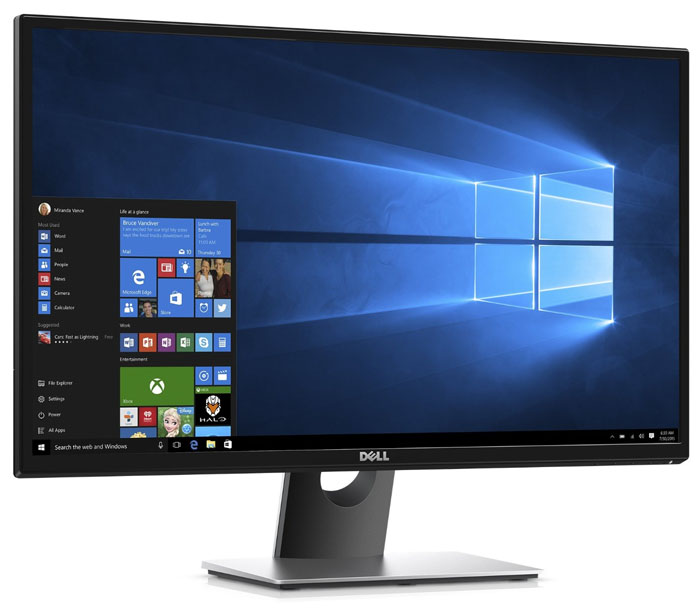Early Verdict
At this price level, it’s hard to imagine a better 27" gaming monitor than the Dell SE2717H. It offers plug-and-play accuracy and FreeSync that will match well with most gaming systems. Its lower 48Hz limit may be a problem for those with older graphics boards, but we think the majority of gamers concerned with value will find it a great addition to their systems.
Pros
- +
Out-of-box accuracy
- +
Gamma tracking
- +
IPS panel
- +
FreeSync
- +
Low input lag
- +
Responsive screen
- +
Styling
Cons
- -
Limited stand adjustments
- -
Narrow FreeSync window
- -
Only one digital video input
Why you can trust Tom's Hardware
Introduction
After reviewing the excellent Asus VG245H, we hope to see a trend towards more affordable gaming screens with refresh rates above 60Hz and adaptive-sync. G-Sync is still a premium technology found in higher-end displays, but AMD’s FreeSync adds no cost to the manufacture of a monitor. Therefore, we should be seeing some great deals as more choices become available.
It’s well established that displays equipped with FreeSync offer a cost savings over their G-Sync counterparts. But when you add in things like QHD or Ultra HD resolution, large IPS panels and refresh rates up to 144Hz, it’s hard to keep the price from creeping upward. By reducing both resolution and refresh to a level more in keeping with mid-priced gaming systems, it’s possible to buy a monitor well suited for gaming that won’t cost much more than a 60Hz business-class screen.
Today we’re looking at Dell’s SE2717H. Unlike much of its value-oriented competition, it offers IPS technology (rather than TN), along with FHD resolution and a 75Hz max refresh rate. Is this enough to satisfy a gamer’s needs? Let’s take a look.
Specifications
$200 can buy a decent gaming monitor, but you’ll have to forgo high pixel density and fast refresh to get there. It is quite possible for an FHD screen to provide an equal gaming experience to a QHD or UHD product if other elements are present and implemented correctly. Adaptive-sync is at the heart of the SE2717H’s feature list. AMD’s FreeSync provides refresh rate matching over a range of 48-75Hz. This is somewhat narrow, and the lower number is a bit higher than most. But with a relatively low pixel-count, it isn’t too difficult to keep framerates above 48 FPS even with a modestly-equipped gaming system.
Many gaming monitors, even expensive ones, use a TN panel to ensure the fastest possible screen draw and the lowest input lag. IPS is no slouch though. In our experience, the differences are literally just a few milliseconds. In fact, refresh rate has a far greater impact on performance than panel type. We have yet to see a fast refresh gaming monitor with visible input lag.
The SE2717H looks quite attractive on paper. In addition to the features already mentioned, the backlight is flicker-free, and as you’ll see in our benchmark tests, color is very accurate out of the box, and contrast is competitive with other displays in its class. It’s also an 8-bit native panel which should keep banding to a minimum. While many users lust for QHD in the 27" size, that’ll raise the price by at least $200; more if you throw G-Sync into the mix. This looks like a great choice for more modest budgets. Let’s examine closer.
Packaging, Physical Layout & Accessories
Dell continues its current trend of eco-friendly lightweight packaging with a clamshell-type carton that opens to reveal a molded paper pulp insert holding the contents. It’s far lighter than Styrofoam and much easier to recycle too. Protection from shipping damage seems to be adequate. The SE2717H is now the third monitor we’ve reviewed that's packed this way, and so far, there hasn’t been a scratch on any of our samples. The base and upright are assembled with a captive bolt, and then snapped onto the panel at a point near its bottom edge.
Get Tom's Hardware's best news and in-depth reviews, straight to your inbox.
The power supply is internal so an IEC power cord is provided in the box. You also get HDMI and VGA video cables. A printed quick start guide is included as well as a CD with the full user’s manual.
Product 360
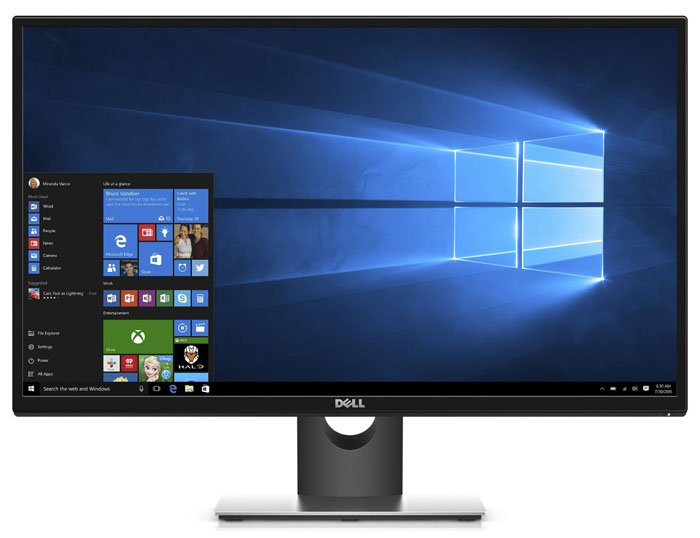
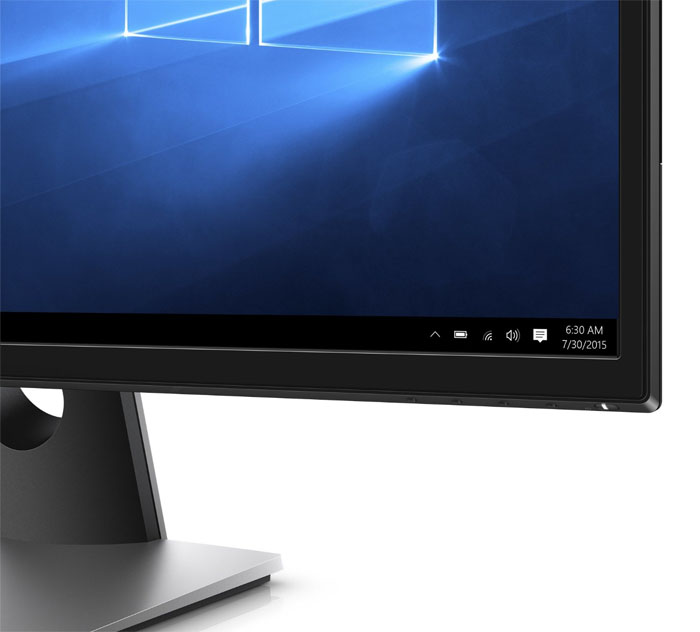
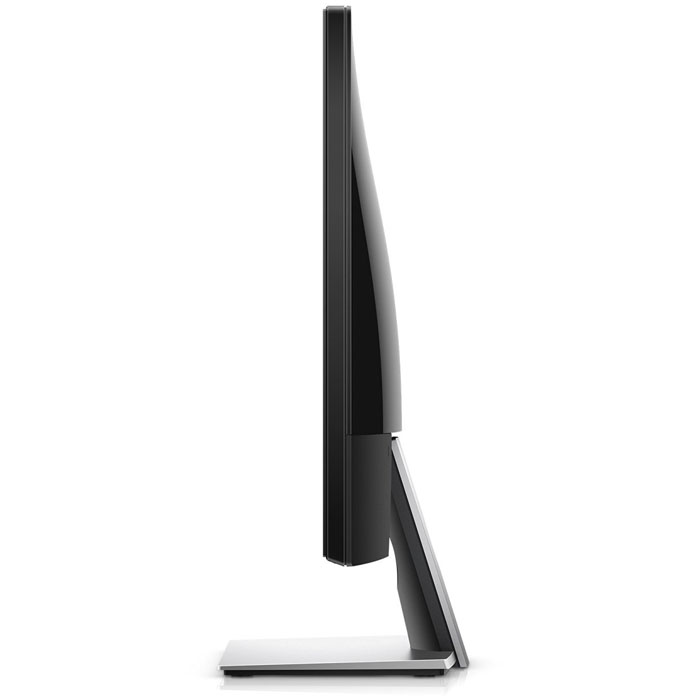
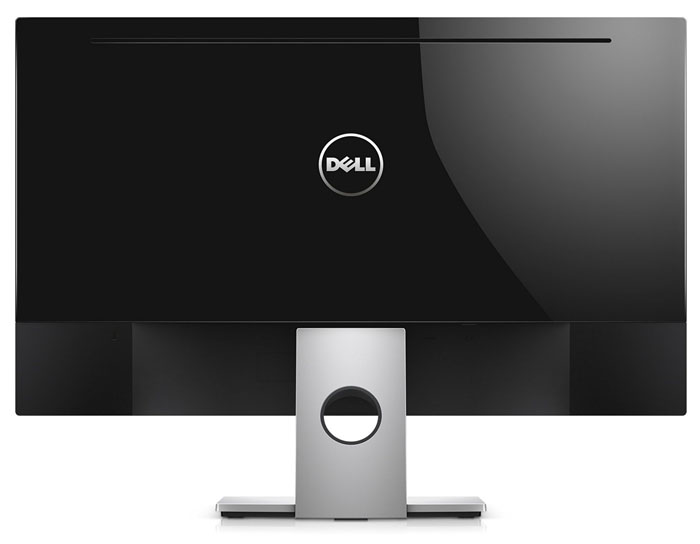

The bezel is fairly narrow at 10mm around the top and sides, and 15mm across the bottom. It fits tightly and won’t present an overly thick line between screens in a multi-monitor setup. The plastic is finished in a high gloss, which extends around the sides and back. These parts can pick up fingerprints with ease so handle with care once you’ve removed the protective wrap.
Controls consist of tiny buttons on the right-bottom edge of the panel. They aren’t marked, so you have to find them by feel. Once you press one, icons appear on the screen denoting their functions. Keys click firmly and respond without delay. To turn on the power, press the LED.
The stand offers only a tilt adjustment. There is no swivel, height or portrait feature. The fulcrum is low, so when you rock the screen back, its top moves further away. Since it’s an IPS panel, placement isn’t overly critical. Everything seems solid, and movements happen without any extra play. The finish looks like aluminum, but it’s actually a high-quality plastic. Underneath the shells are heavy cast and stamped metal parts. For a budget screen, the SE2717H has decent heft.
The side profile is slim, but we were disappointed to see USB ports omitted. The other missing element is any sort of audio support. You don’t get speakers or a headphone output.
The back is smooth and finished in the same piano black as the rest of the chassis. The low-mounted stand means there’s no provision for a VESA mount. It also means the input panel is a bit hard to reach. Fortunately, there isn’t too much to plug in.
Inputs include one each of HDMI and VGA. FreeSync and 75Hz work just fine without DisplayPort as long as you make sure to update AMD Catalyst. We were using an older version that doesn’t support FreeSync over HDMI. A quick download solved our problem. We haven’t seen a monitor with just one digital video input since the first G-Sync monitors came out only sporting a single DisplayPort. For most users it won’t be an issue, but those who wish to add a second source like a Blu-ray player or gaming console may wish for that extra HDMI port.
MORE: Best Gaming Monitors
MORE: Best Professional Monitors
MORE: How We Test Monitors
MORE: How To Choose A Monitor
MORE: All Monitor Content

Christian Eberle is a Contributing Editor for Tom's Hardware US. He's a veteran reviewer of A/V equipment, specializing in monitors. Christian began his obsession with tech when he built his first PC in 1991, a 286 running DOS 3.0 at a blazing 12MHz. In 2006, he undertook training from the Imaging Science Foundation in video calibration and testing and thus started a passion for precise imaging that persists to this day. He is also a professional musician with a degree from the New England Conservatory as a classical bassoonist which he used to good effect as a performer with the West Point Army Band from 1987 to 2013. He enjoys watching movies and listening to high-end audio in his custom-built home theater and can be seen riding trails near his home on a race-ready ICE VTX recumbent trike. Christian enjoys the endless summer in Florida where he lives with his wife and Chihuahua and plays with orchestras around the state.
-
ArnisR Pixel Response & Input Lag diagrams are wrong. They are duplicates of uniformity diagrams.Reply -
Adroid You know, I have been eyeing the ASUS Rog PG279Q because I'm currently running a NVidia card, but at 800$ it's a hard pill to swallow. Seeing a good quality screen like this, when you add a 500$ graphic card, it's still less than the Asus monitor alone, makes you really second guess spending that much.Reply
I'm an "old school" gamer, and I am pretty bummed that 16:10 is essentially a lost cause. People don't realize that it's a superior resolution, in particular for MOBA and RTS games where battles can be taken place vertically... I'm thinking about the 1440p screen because it will give a bit more than the 1920x1200 I'm currently using, but dang I wish I could find a ULMB Gsync/freesync screen with 2560x1600 and at least 120hz - but I'm sure not holding my breath. -
Rassalas Isn't 1080P kind of out of date nowadays? I would think at least 4K would be the lower threshold for something to brag about.Reply -
Adroid 1080p is OK. Depends on what you are doing. You have to consider on FPS games the larger the resolution, the smaller your targets will be. For example, CS:GO at 4k would be very difficult to make "flick shots", which is game lingo for flicking your mouse and shooting faster than your eyes can keep up. It's essentially a controlled shot blind, developed from many hours of play and settings on the mouse that fit the player.Reply
For MMO games, and I'm sure a number of other games and genres, the bigger the resolution, the better - provided the game has proper scaling for text and interface. What I mean is there are certain games if you run at 4k the text is unreadable because it's so small... In this case a smaller resolution is the only answer. 1080p is pretty much the "standard" that all games work towards, so I would guess confidently that most, if not all, games will support it (modern games do undoubtedly).
But to answer your question, no, I wouldn't say it's out of date. It's the most common resolution for streaming, video, and compatible with 99.9% of game systems, TVs, media, and the list goes on (albeit 1080p is not 100% to scale in most video thanks to the biggest blunder of our time). -
photonboy Adroid,Reply
You do not gain anything with a more square aspect, in fact you LOSE by seeing less information to the sides.
Scaling issues aren't much of an issue today either in terms of game text. Also, I have no idea what "blunder" you are referring to with 1080p and video scaling.
16x9 is the ideal ratio for a screen. -
AdMan The Congrats and thanks again for your continuous, voluntary, reliably-dependable, sub-conscious and especially in this week's historically insignificant instance Your inpatient and passionate participation in:Reply
"Eternally Distracted Sheeple - Sustained by Sh!tty Fodder from Greedy Farmers"
It's NOT AN ART! It is Science, Social Engineering, Years of Persistent, Neural++
RE-Programming, behavior modification, positive and negative sanctions, etc., etc.,
PERSONALIZATION: Promoting, Procuring, Providing "Personalized Power Products" to Multiple Massive Markets - Irregardless of the Socio-Economic Demographics by EMPLOYING THE UBER-EGO...
Sharing is caring and caring is sharing,
SO...Let's end all that silliness and all get sorted right now....
UNDERSTAND, and accept these simple Rules, we all PASS with BONUS Points!
Rule#1: LOCATION! LOCATION! LOCATION!
Rule#2: QUALITY then Quantity.
Rule#3: Live, Laugh, Love
Rule#4: 10000x7000 (IMAX)
*I took a few minutes to really research this, for my own agenda
(Perceived Needs/Wants) VERSUS (Actual Needs/Wants).
A few minutes turned into several hours and a savings of several thousand dollars much better understanding. Additionally - A sincere thank you to ALL Y'ALL.
I thought I knew, that what I knew, was correct and true, pausing to check my facts stopped my ignorance in it's tracks and availed me the opportunity to learn as well as urge all of you to spend a few minutes fact checking yourself and the other interested parties.
With my High and Mighty Attitude of Gratitude - Peace out! -
Syed_Listening How about the after purchase experience on this? Will there be replacement or repair?Reply -
Syed_Listening How about the after purchase experience on this? Does Dell provide a replacement or repair?Reply
